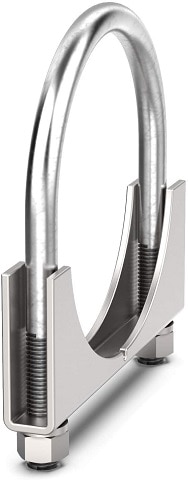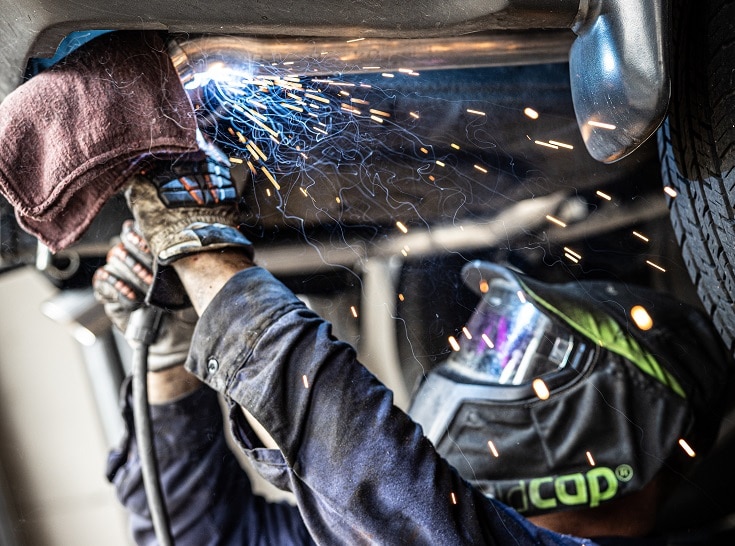Exhaust Clamps vs Welding: What’s the Difference & Which is Right for Your Needs?
Last Updated on
If you have a problem with your exhaust system and intend to fix it yourself, you probably have several questions, especially if you should use exhaust clamps or welding to keep the pipes in place. We’re going to take a close look at both methods and tell you about the pros and cons of each, so you will know what the better choice for your situation is.
Keep reading while we discuss ease of use, expense, durability, and other factors to help you make an educated decision.
Overview of Exhaust Clamps:
Exhaust clamps are specialized for holding two pipes together under extreme heat. Lesser clamps can stretch and corrode more easily with high heat, so you’ll want to use one of these three kinds of clamps to keep your muffler pipes tight and free of noise, and they are band, U-bolt, or V-band clamps.
Band Clamps
Band clamps are versatile and permanent clamps, often made from aluminum, galvanized, or stainless steel. It comes in a range of adjustable sizes and will fit most muffler exhaust pipes. They are easy to use and tighten with a compatible clamping tool. We recommend using galvanized or stainless steel for better heat resistance.
U-Bolt Clamps
While band clamps have many uses, you typically only see u–bolt clamps on automotive muffler systems. As the name suggests, it has a U-shaped bolt that fits around the pipe. As you tighten the clamp, the bolt pushes the pipe into a toothed brace that won’t allow the pipe to turn or come apart. The U-bolt clamp is the type you’ll find on most vehicle muffler systems. It comes in various sizes to fit any exhaust.

V -Band Clamps
A V-band clamp is the most complex of the three. It has three pieces, one piece for each pipe end that creates a lip, and one is like a collar that you place over the two to hold them in place. The groove in the collar piece that holds the two pipe ends together has a V shape for maximum tightness when you clamp it down. You usually see these clamps on high-end systems that must withstand higher airflow than most vehicles produce. The downside to these clamps is that you need to weld the pieces onto the end of the pipes.
- Easy to use
- Can install yourself
- Can install with the muffler on the vehicle
- Can disassemble
- Not as strong a bond as welding
Overview of Welding:
Welding provides you with a stronger bond than a clamp can and will last the pipe’s lifetime. The downside of welding is that you need specialized skills and tools. If you don’t have the tools, you will need professional assistance. Another problem is that it is not hard to weld before you attach it, but if you have to repair a broken exhaust, it’s much more difficult.
Welding heats two metals to the melting point and introduces a filler material to fuse the materials and create a strong bond. There are several types of welding you can use.
TIG Welding
Tungsten Inert Gas welding is better known as TIG welding. It’s a type of arc welding that uses a non-consumable tungsten electrode. The welding area is protected from oxidation by an inert gas like helium or argon. You use filler metal and a strong electric current to create an arc. You usually use it to weld stainless steel, copper, aluminum, and magnesium. It provides a better weld than other methods but is more complex and requires a more complex set-up. It’s also a bit slower than other methods.

MIG Welding
Gas Metal Arc welding is better known as MIG welding. It uses a consumable electrode to create an arc that melts the metals and fuses them together. It still requires an inert gas, usually carbon dioxide, to prevent oxidation while your welding, but the set-up is much simpler than TIG welding. Mig welding is used primarily for sheet metal, making it the most common type to find in automotive garages. MIG welding is easy to do and is often automated. The biggest downside to MIG welding is that you can’t do it outside because drafts might push the inert gas out of the way, allowing oxidation to occur.
Stick Welding
Some people might refer to stick welding as Shielded Metal Arc Welding, and like the other types we’ve mentioned so far, it requires electricity to create an arc. You put the project on a metal table and connect it to the negative on your power supply. The positive terminal holds your stick; a flux-covered consumable electrode that you use to create the bead to join your two metals together. Unlike the other types of welding we’ve discussed, stick welding does not require an inert gas because the flux on the stick prevents oxidation, allowing you to weld outside without worrying about drafts. Stick welding is the simplest type of arc welding.
Flux-Cored Welding
Flux-cored welding is the last type we will look at, and like the others, it will require electricity. This type is similar to stick welding, but it places the flux on the inside of a hollow metal consumable tube. You can use it with inert gas or without, and you can use it to weld outside.
- Strong bond
- Requires safety equipment
- Requires electricity
- Requires knowledge and skill
- Difficult to do repairs in place.
What Should I Use? Exhaust Clamps vs Welding
When making a decision on whether to use exhaust clamps or welding to fix your exhaust pipe, we recommend using clamps to connect your exhaust system, whether it’s new or you’re making repairs to a damaged one.
If you are an experienced welder, have the tools, and are putting your exhaust on a high-performance vehicle, you might choose to permanently weld the pipe since you will need to weld V-band clamps anyway. However, clamps will work better for most people, especially once the exhaust system is in place because it will be difficult to weld around the pipe. The exhaust system rarely requires complete replacement. It’s much more common and less expensive to replace sections of pipe, meaning 90% of the work done to it will happen with the exhaust system in place.
When choosing your clamp, the U-bolt is the most common and is what most automotive companies use. They are the easiest to apply and the type we recommend. The downside to these clamps is they tend to rust badly because of the nooks and crannies in their design, so they may be hard to remove and may even need replacing.
Final Thoughts
We hope that you have enjoyed reading over our comparison between these two methods of repairing your exhaust system (exhaust clamps vs welding), learned about the difference & made a decision on which is right for your needs. You have many options available to you, but if you are looking for the cheapest way that doesn’t require any experience or special tools, the U-bolt clamp is your best bet, followed by V-band clamps that would allow you to replace sections of pipe as needed. If we have helped answer your questions, please share this shootout between exhaust clamps and welding on Facebook and Twitter.
Featured Image: Left: Clamping exhaust (Source: Jason Swaby, Flickr) | Right: Welding exhaust (Source: Flattrackers and Caferacers Parts and bikebuilds, Flickr)
